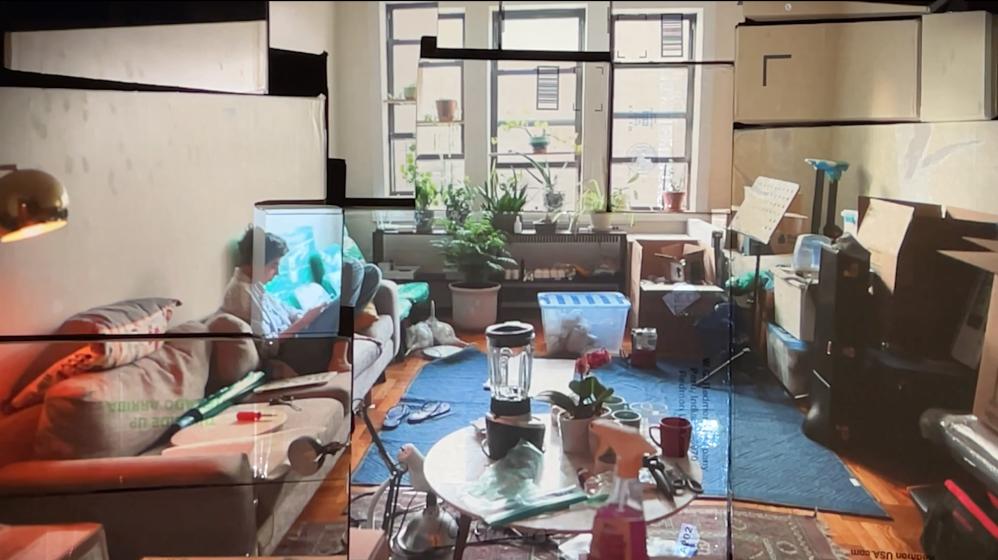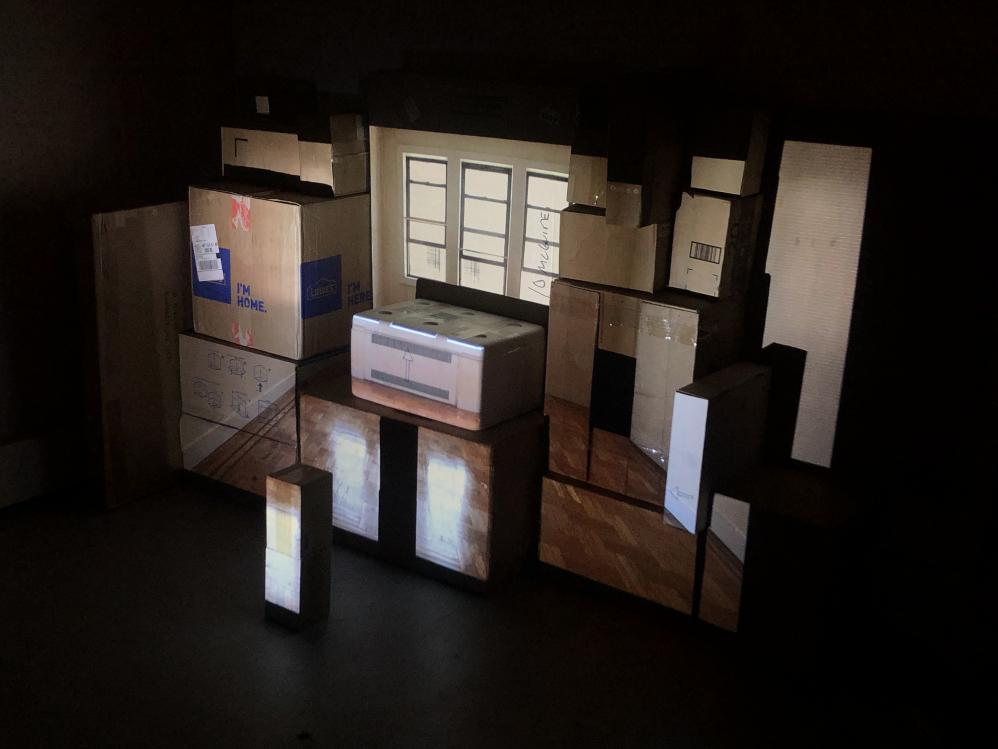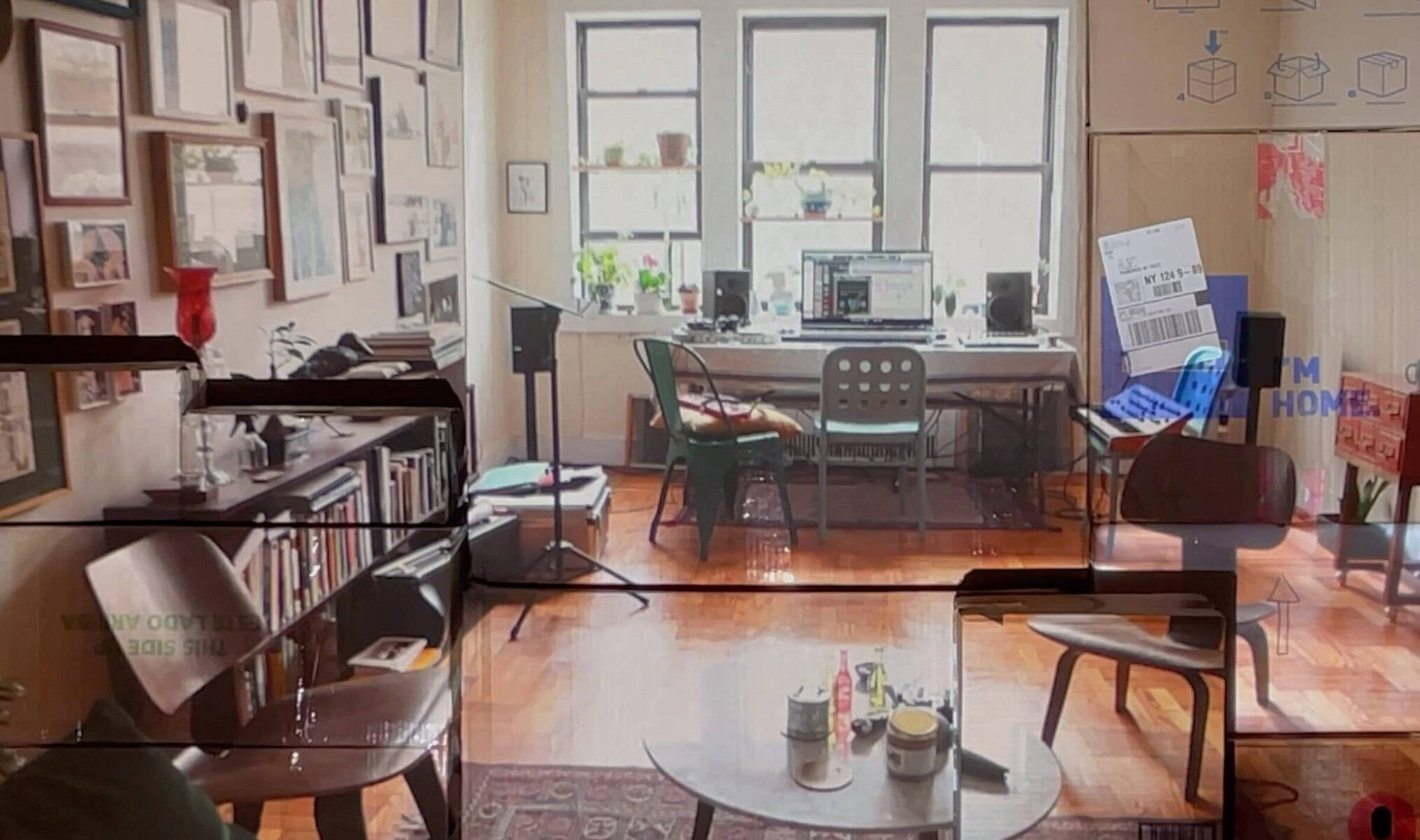The process of moving brings up the vulnerability of migration/immigration, and the making/unmaking of memories. Like a plant soon to be repotted, it occupies the liminal point between a chapter of life that is about to be closed, and a new phase where roots would soon grow in resilience and burrow deep into the soil. Time and place are inextricably tied to the physicality of the body and things. Created during the BRIClab residency, Sareh Imani’s video piece Center is not a particular point on earth (2020) documents the artist’s process of moving from Brooklyn, New York, to a farm in upstate New York.
After the pandemic hit, Imani found herself unable to continue her usual practice of sculpture and video-making, it was a dilemma that many artists found themselves in. In a self-reflexive move, she started experimenting with using a camera to film her daily life. Set up in a corner on a stationary tripod, it became witness to the chaos and reconfiguration that unfolded as she and her partner decided to wrap up their things and move out of their apartment in the city. Static long shots capture mundane activities such as playing music, working on computers, and wrapping objects in bubble wrap. As I watch on, the subtlety of motion is brought to the surface, birds chirping, a fan whose vibration holds both stillness and anticipation.

For Imani’s solo exhibition at A.I.R. Gallery (November 20 to December 20, 2020), a three-channel video was projected onto stacks of used cardboard boxes–which are in themselves a charged signifier of change and upheaval. As a fellow immigrant, and someone who has had to move around quite frequently, I have always had an aversion towards cardboard boxes. Just by looking at them, I can almost feel the grating sounds of cardboard flaps rubbing against each other. The effect is in fact psychosomatic, because it is inseparable from accompanying feelings of uncertainty, insecurity. I have known many in my community who have long outstayed their living situations, simply to avoid falling into the void of negativity associated with moving.

These containers, exhibiting signs of wear and tear, create a landscape featuring different kinds of written and printed media. Sareh produced a new iteration of the work, by filming the physical installation previously shown at A.I.R. and turning it into digital media that could be viewed online. The resulting product is a hybrid landscape that sheds light on the way bodies inhabit varying spatial dimensions. Directional arrows, instructions for putting the boxes together, postal labels, and even the phrase “I’m home” are permanently incorporated into the scene like a superimposed effect, or a carefully-placed graffiti. Whether hovering on the wall, or cheekily pointing towards a laptop screen in the video, these otherwise commonplace signs are transformed into readymade media objects, accruing new layers of meaning as we get a glimpse into the interplay between domesticity and interiority.
To make this iteration, Imani repeatedly played with different arrangements of boxes, stacking, rotating, and reorienting them to build a stage for a domestic drama to play out, so much so that she knew the routine like the back of her hand. Unsurprisingly, homemakers are always good at playing the game of tetris, out of a necessity to arrange things well to make the maximum room, for both physical-emotional wellbeing.
The art of rearranging and reconfiguring applies not only to the personal-domestic realm, but also to artists’ practices. Even in unprecedented times, people are by no means immune from operating under an overarching framework of capitalist work ethic, in which artists are expected to pick up a whole new set of skills or develop a new body of work during periods of lockdown. As ‘aliens’ whose survival is dependent on the endless demonstration of their distinction, immigrant artists and art workers are often propelled by linear vision, attachment to authorship, and even obsessive-compulsive control over one’s narrative. Therefore, these long, patient shots that fully reveal space and its inhabitants push back against hyperactivity, our limited understanding of productivity, and social constraints–they force me, the viewer, to detect small details, and be confronted with the relationship between space and place, the body and identity.
In Imani’s video, the positioning of the camera in a confined space unearths the sonic flow of traffic specific to Brooklyn, an orientation towards new horizons, and a transformative work-to-life configuration. It recalls to my mind Taiwanese filmmaker Tsai Ming-liang’s long takes–brimming with repressed desires and a search for a sense of belonging in alienating urban environments– stillness, prolonged monotony soak into the body for the moment to be minutely absorbed. In fact, underlying an aesthetics of boredom is motion towards change and dynamism. A tremor, a vibration, a small glint of anticipation.
In Center is not a particular point on the earth’s surface, crevices and shadows between the boxes could be seen as a metaphor for fractured experiences and sense of self/place; the varying surfaces of the boxes create a distortion effect, so that bodies moving between them seem to be transitioning from one dimension to the next. Yi-Fu Tuan writes in Space and Place: The Perspective of Experience, from which Imani derived the title of the work, “objective reference points in space, such as landmarks and the cardinal positions, conform with the intention and the coordinates of the human body.” From a geographer’s unique vantage point, Tuan articulates how architectural terms such as axis of orientation, elevation, unit measurements are organized in conformity with the surfaces of the body. Center, then, denotes a structure of hierarchy that shifts according to one’s corporeal orientation to a spatialized landscape.
Imani’s previous projects actively negotiate physical distance through materiality and intimacy. Kindred Spirit, a three channel video, shows advice from the artist’s parents on how to save a dying cactus in a facetime call, an ear-reconstructive surgery, and Imani trying to repair a broken sculpture made by her mother. Even though the family is scattered in different places, the capacity for touch through the transmission of care breaks through boundaries created by the geopolitical dispersion of centers. Another work, They say the sky is the same everywhere, explores landscapes’ capacity to connect. Imani collected used postcards, and blacked out the foreground in these images so that only the sky is showing. Like the way the moon serves as an eternal signifier of homesickness in Chinese poetry, the sky, in all its shapes and colors, brings out the common linkages in people regardless of their backgrounds.
For those afflicted with diasporic melancholia, the triangulation between distance, home-making, and intimate identification can be particularly trying. Having recently gone through a strenuous move to Sunset Park, Brooklyn, I had an illuminating but otherwise quotidian moment during a stroll in the neighborhood. Just as I was about to reach Eighth Avenue, a major street that runs through Brooklyn’s Chinatown, I felt a soothing sense of familiarity wash over me, at the same time a foreign sensation of being a tourist. Cars blasting C-pop hits from the 2000s, cheap multi-colored dish sponges were enough to move me to tears. My perceived otherness faded as soon as it was made redundant. After all, this cathartic moment took place after an intense period of self-isolation, where access to familiar sensations and stimulations was severely limited.
The body’s cardinal center, when realigned with one’s attachment to place, creates a massive shift in perception. Space cradles and holds the body, yet the body is the fundamental metric that determines the way space is perceived and experienced. Center is not a particular point on the earth’s surface adaptively set up a domestic stage for the unfolding of time, and the folding and refolding of space. Fortunate for me, it conjured up dialogues that affirmed the potency and vulnerability of homemaking, and of course, home-unmaking.
Banyi Huang (born in Beijing) is a writer, curator, and designer based in New York. She is interested in exploring aspects of gender, labor, and mythology through writing, digital media, and 3D design. Banyi has realized curatorial projects at Special Special (New York), PRACTICE Yonkers (New York), and Assembly Room (New York), and has contributed writing to the Brooklyn Rail, Hyperallergic, Frieze, ArtAsiaPacific, OCULA magazine, Artforum China, and Performa Magazine. She currently works as a project coordinator at Special Special, a gallery and shop in East Village.
